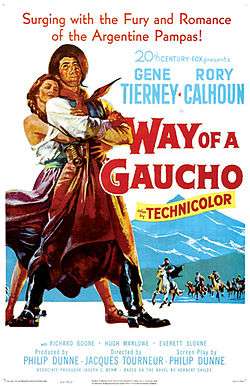Way of a Gaucho
| Way of a Gaucho | |
|---|---|
|
Theatrical release poster | |
| Directed by | Jacques Tourneur |
| Produced by | Philip Dunne |
| Written by |
Herbert Childs (novel) Philip Dunne |
| Based on | The novel Way of a Gaucho by Herbert Childs |
| Starring |
Gene Tierney Rory Calhoun Richard Boone Hugh Marlowe |
| Music by | Sol Kaplan |
| Cinematography | Harry Jackson |
| Edited by | Robert Fritch |
Production company | |
| Distributed by | 20th Century Fox |
Release date |
|
Running time | 95 minutes |
| Country | United States |
| Language | English |
| Budget | $2,239 million |
| Box office | $1.4 million (US rentals)[1] |
Way of a Gaucho is a 1952 American western film directed by Jacques Tourneur and starring Gene Tierney, Rory Calhoun and Richard Boone. It was scripted by Philip Dunne and based on a novel by Herbert Childs.
The film failed to make a profit on its release. The story portrays the adventures of an Argentine rebel Gaucho, a South American rural worker sometimes considered as a version of the cowboy.
Plot
In 1875 Argentina, a young gaucho kills another man in a duel. His prison sentence is commuted to join the army. He serves under the tough Major Salinas, but soon grows tired of military life and deserts. He becomes Val Verde and leads a band of gauchos to resist the increasing encroachment of railroad agents into the Pampas. In the meantime Salinas quits the army and becomes chief of police, so he can continue his vendetta against him. After falling in love with an aristocratic woman, Martin decides to escape with her to Chile, crossing the Andes on horseback. On the way Teresa tells him that she is pregnant, so they decide to return and get married instead, because of her safety and that for them is inconceivable for the child to be raised without a legitimate last name. When they arrive at the Cathedral, the police follows them so Martin has to escape again, leaving Teresa in the care of Father Fernandez. That night Miguel talks with Teresa about a deal he reached with the Governor, in which Martin voluntarily turns himself in, in exchange for a 3 year prison sentence and a clean slate. Teresa tells Miguel where Martin is hiding, but Salinas also follows, prompting a horse chase through a cattle run, that causes Miguel to fall from his horse and be trampled to death by the herd of cows. That same night, Martin returns filled with guilt to meet Teresa and while she offers to escape to Brazil or Europe, he declines and tells her to meet him at noon at the Cathedral. The next day Father Fernandez arranges a meeting alone with Salinas, where Martin agrees to turn himself in and face the consequences of his actions, as long as he can first marry Teresa as a free man.
Main cast
- Rory Calhoun as Martín Peñaloza/Martin Penalosa/The Rebel Valverde
- Gene Tierney as Teresa Chavez
- Richard Boone as Major Salinas
- Hugh Marlowe as Don Miguel Aleondo
- Everett Sloane as Falcon
- Enrique Chaico as Father Fernández
- Jorge Villoldo as Valverde
- Ronald Dumas as Julio
- Hugo Mancini as Army Lieutenant
- Néstor Yoan as Army Lieutenant
Production
The film was made by 20th Century Fox and shot on location in Argentina. It was one of a growing trend of Runaway productions which saw American production shift away from Hollywood to other countries, particularly Britain and Italy, where the Hollywood studios had large amounts of money frozen because of currency controls. During World War II the Argentinian market had remained open to Hollywood films and Fox had built up significant earnings which they were unable to spend outside the country.
Henry King was originally intended to be the director, but he became unavailable and was replaced by Tourneur. Apart from the leading parts, English-speaking Argentine actors were hired. The film's production was troubled, in part because of a tense relationship between the filmmakers and the Peronist government of Argentina. The story is freely based on the epic poem Martín Fierro (1872 and 1879) by Argentine poet, politician and journalist José Hernández. The film's producer and screenwriter Philip Dunne observed that Juan Peron's followers "had made the legendary gaucho, then almost extinct, a national hero and symbol of their own aggressive nationalism" and the script was closely monitored by the Minister of Information Raul Apold.[2] The budget overran by $413,000 and eventually cost $2,239,000.[3]
Legacy
The making of a Gaucho film in Argentina by a major United States film studio inspired the local studios to make a Western movie in Argentina for the first time. El último cow-boy (The Last Cowboy) is the result, an Argentinian black and white film directed by Juan Sires, based on the script by Eric Della Valle and Miguel Petruccelli, that premiered on February 25, 1954 and had as its cast: Augusto Codeca, Hector Calcaño, Hector Quintanilla and Pedro Laxalt. The film was initially going to be called "Camino del Cow-boy" (The Way of The Cowboy), seeking to replicate in jocular form Tourneur's Camino del Gaucho/Way of a Gaucho.
References
Bibliography
- Fujiwara, Chris. Jacques Tourneur: The Cinema of Nightfall. McFarland & Co, 1998.
- Lev, Peter. The Fifties: Transforming the Screen 1950-1959. University of California Press, 2003.
- Solomon, Aubrey. Twentieth Century-Fox: A Corporate and Financial History. Scarecrow Press, 1988.
